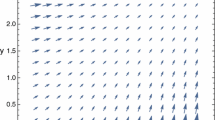Abstract
Models of the coupling of electromagnetic and gravitational fields have been studied extensively for many years. In this paper, we consider the coupling between the Maxwell field and the Weyl tensor of the gravitational field to study how the wavevector of the electromagnetic wave is affected by a plane gravitational wave. We find that the wavevector depends upon the frequency and direction of polarization of the electromagnetic waves, the parameter that couples the Maxwell field and the Weyl tensor, and the angle between the direction of propagation of the electromagnetic wave and the coordinate axis. The results show that this coupling model can be tested by the detection of high-frequency gravitational waves.
Similar content being viewed by others
References
I. T. Drummond, and S. J. Hathrell, Phys. Rev. D 22, 343 (1980).
A. B. Balakin, and J. P. S. Lemos, Class. Quantum Grav. 22, 1867 (2005), arXiv: gr-qc/0503076
A. B. Balakin, V. V. Bochkarev, and J. P. S. Lemos, Phys. Rev. D 77, 084013 (2008), arXiv: 0712.4066.
V. Faraoni, E. Gunzig, and P. Nardone, Fundament. Cosmi. Phys. 20, 121 (1998).
F. W. Hehl, and Y. N. Obukhov, How Does the Electromagnetic Field Couple to Gravity, in Particular to Metric, Nonmetricity, Torsion, and Curvature? In: Gyros, Clocks, Interferometers…: Testing Relativistic Graviy in Space. Lecture Notes in Physics. Vol. 562 (Springer, Berlin, Heidelberg, 2000), p. 479.
G. M. Shore, Nucl. Phys. B 605, 455 (2001).
G. Li, and X. M. Deng, Ann. Phys. 382, 136 (2017).
G. Li, and X. M. Deng, Commun. Theor. Phys. 70, 721 (2018).
W. T. Ni, Phys. Rev. Lett. 38, 301 (1977).
R. Lafrance, and R. C. Myers, Phys. Rev. D 51, 2584 (1995).
M. Novello, L. A. R. Oliveira, and J. M. Salim, Class. Quantum Grav. 13, 1089 (1996).
J. Jing, S. Chen, and Q. Pan, Ann. Phys. 367, 219 (2016), arXiv: 1510.03316.
A. Ritz, and J. Ward, Phys. Rev. D 79, 066003 (2009), arXiv: 0811.4195.
J. P. Wu, Y. Cao, X. M. Kuang, and W. J. Li, Phys. Lett. B 697, 153 (2011), arXiv: 1010.1929.
D. Z. Ma, Y. Cao, and J. P. Wu, Phys. Lett. B 704, 604 (2011), arXiv: 1201.2486.
S. Chen, and J. Jing, Phys. Rev. D 88, 064058 (2013), arXiv: 1307.7459.
S. Chen, and J. Jing, Phys. Rev. D 89, 104014 (2014), arXiv: 1310.1807.
S. Chen, and J. Jing, Phys. Rev. D 90, 124059 (2014), arXiv: 1408.5324.
S. Chen, and J. Jing, J. Cosmol. Astropart. Phys. 2015(10), 002 (2015), arXiv: 1502.01088.
S. Chen, S. Wang, Y. Huang, J. Jing, and S. Wang, Phys. Rev. D 95, 104017 (2017), arXiv: 1611.08783.
H. Liao, S. Chen, and J. Jing, Phys. Lett. B 728, 457 (2014), arXiv: 1312.1144.
J. Li, Z.-C. Che, and Q.-G. Huang, Sci. China-Phys. Mech. Astron. 62, 110421 (2019).
R. Niu, and W. Zhao, Sci. China-Phys. Mech. Astron. 62, 970411 (2019), arXiv: 1812.00208.
X. L. Fan, J. Li, X. Li, Y. H. Zhong, and J. W. Cao, Sci. China-Phys. Mech. Astron. 62, 969512 (2019), arXiv: 1811.01380.
X. Zhang, Sci. China-Phys. Mech. Astron. 62, 110431 (2019).
F. Y. Li, M. X. Tang, and D. P. Shi, Phys. Rev. D 67, 104008 (2003), arXiv: gr-qc/0306092.
F. Li, H. Wen, Z. Fang, L. Wei, Y. Wang, and M. Zhang, Nucl. Phys. B 911, 500 (2016), arXiv: 1505.06546.
F. Y. Li, H. Wen, Z. Y. Fang, D. Li, and T. J. Zhang, arXiv: 1712.00766.
R. Zhang, and J. Jing, Eur. Phys. J. C 78, 796 (2018).
Author information
Authors and Affiliations
Corresponding author
Additional information
This work was supported by the National Natural Science Foundation of China (Grant Nos. 12035005, and 11875025), and the National Key Research and Development Program of China (Grant No. 2020YFC2201400).
Rights and permissions
About this article
Cite this article
Zou, Y., Wang, M. & Jing, J. Test of a model coupling of electromagnetic and gravitational fields by using high-frequency gravitational waves. Sci. China Phys. Mech. Astron. 64, 250411 (2021). https://doi.org/10.1007/s11433-020-1674-0
Received:
Accepted:
Published:
DOI: https://doi.org/10.1007/s11433-020-1674-0




